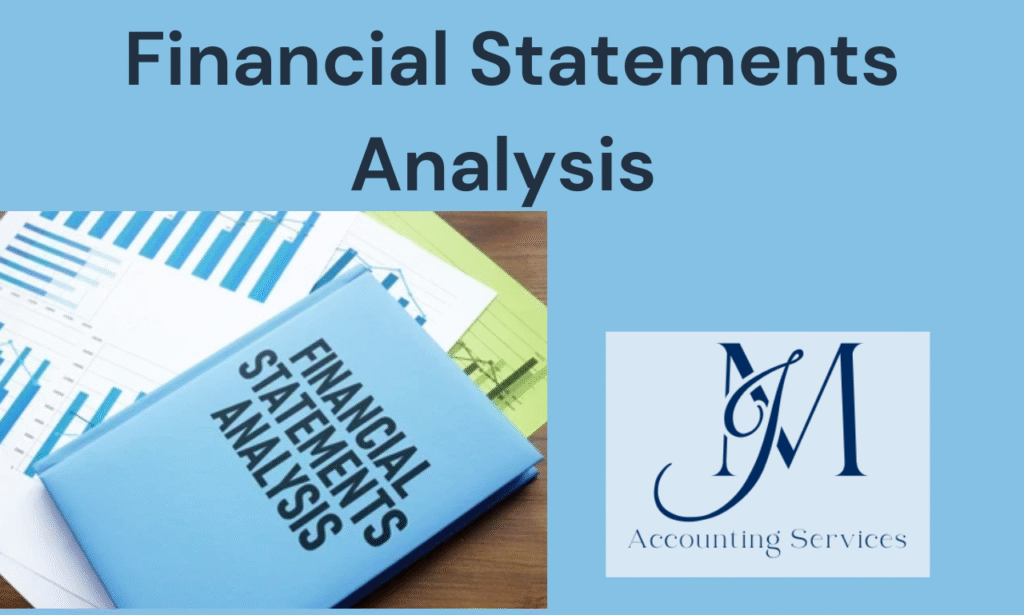
Financial statement analysis evaluates a company’s performance through its financial reports, including the income statement, balance sheet, and statement of cash flows. Businesses use this process to assess profitability, liquidity, and solvency, guiding strategic decisions. This article explains how to perform financial statement analysis and where to hire professionals, such as remote accountants or virtual bookkeepers, to assist with preparation. The focus is on practical steps, reliable data, and professional support to ensure accurate financial reporting best practices.
How Do You Perform Financial Statement Analysis?
Financial statement analysis is performed by examining a company’s income statement, balance sheet, and statement of cash flows to evaluate its financial health. The income statement shows revenue, expenses, and net income, revealing profitability trends. For example, a retail company’s income statement might list $500,000 in sales and $300,000 in costs, yielding a $200,000 profit. The balance sheet details assets, liabilities, and equity, indicating solvency. A manufacturing firm’s balance sheet could show $1 million in assets and $400,000 in liabilities, suggesting strong financial stability. The statement of cash flows tracks cash inflows and outflows, highlighting liquidity. A tech startup’s cash flow statement might indicate $100,000 in operating cash flow, ensuring it can cover short-term obligations. Analysts use ratios like the current ratio (current assets divided by current liabilities) and return on equity (net income divided by shareholders’ equity) for deeper insights. According to a 2023 study from Harvard Business School’s Accounting Department, companies using ratio analysis improve decision-making accuracy by 25%. Vertical analysis, comparing line items to a base figure like total revenue, and horizontal analysis, tracking changes over time, further enhance understanding. For instance, a 10% revenue increase year-over-year signals growth. These methods ensure a comprehensive financial overview, supporting strategic planning.
Where Can You Hire an Accountant or Bookkeeper to Help Prepare Financial Statement Analysis?
Remote accountants or virtual bookkeepers to help prepare financial statement analysis can be hired through online platforms specializing in financial services search as JM Accounting Services. These platforms connect businesses with professionals skilled in financial statement preparation, financial reporting best practices, and financial statements analysis. For example, a small business might hire a virtual bookkeeper to organize transactions and a remote accountant to compile a balance sheet and income statement. These experts ensure accuracy in company financial statements, such as a restaurant’s financial sheet showing $200,000 in assets and $50,000 in liabilities. A 2024 report from the University of Chicago’s Booth School of Business found that businesses outsourcing accounting tasks reduce errors in financial reports by 30%. Freelance marketplaces offer access to certified professionals who provide services like reading financial statements or preparing a statement of cash flows. Industry-specific job boards also list accountants experienced in financial summary creation for sectors like retail or tech. These professionals work remotely, offering flexibility and cost savings, with hourly rates often ranging from $25 to $100 based on expertise. This approach ensures businesses access tailored support for accurate financial report writing and analysis.
How Do You Prepare a Financial Statement Analysis?
Financial statement analysis is prepared by collecting and reviewing a company’s income statement, balance sheet, and statement of cash flows to assess its financial performance. Start by gathering accurate financial data from reliable sources, such as accounting software or ledgers. For example, a retail company’s income statement might show $600,000 in revenue and $350,000 in expenses, while its balance sheet lists $1.2 million in assets. Organize data into standardized formats to ensure consistency. Next, calculate key ratios, such as the debt-to-equity ratio (total liabilities divided by shareholders’ equity) or the gross profit margin (gross profit divided by revenue). A 2023 study from Stanford University’s Economics Department found that businesses using standardized ratio calculations improve financial accuracy by 20%. Perform trend analysis by comparing data across multiple periods, like a 15% revenue growth over two years. Use visual tools, such as charts, to highlight trends, ensuring a clear financial overview. Verify data integrity to avoid errors, as inaccuracies can skew results. This structured approach ensures a robust financial summary for decision-making.
What Are the Main Types of Financial Analysis?
The main types of financial analysis are horizontal, vertical, and ratio analysis, each providing unique insights into a company’s financial health. Horizontal analysis compares financial data over time to identify trends, such as a manufacturing firm’s revenue increasing from $500,000 to $600,000 over three years. Vertical analysis expresses each line item as a percentage of a base figure, like total revenue, to assess proportionality. For instance, a tech company’s cost of goods sold might be 40% of its $1 million revenue. Ratio analysis uses metrics like the current ratio (current assets divided by current liabilities) to evaluate liquidity or profitability. A 2024 report from MIT’s Sloan School of Management noted that companies employing all three methods improve strategic planning by 28%. These analyses, applied to financial statements like the balance sheet or income statement, help businesses understand performance drivers. Combining them ensures a comprehensive evaluation, supporting effective financial reporting best practices.
How Does Vertical Analysis Work in Financial Statements?
Vertical analysis works in financial statements by expressing each line item as a percentage of a base figure, typically total revenue for the income statement or total assets for the balance sheet, to evaluate relative proportions. For example, on an income statement with $500,000 in revenue, if operating expenses are $150,000, they represent 30% of revenue. Similarly, a balance sheet with $1 million in total assets and $200,000 in inventory shows inventory as 20% of assets. This method highlights cost structures and resource allocation. According to a 2023 study from the University of Pennsylvania’s Wharton School, vertical analysis improves cost management decisions by 22%. Analysts apply it to company financial statements to compare performance across firms or periods, ensuring consistency. For instance, a retailer might find its marketing expenses, at 10% of revenue, are lower than the industry average of 15%. This clarity aids in preparing financial statement analysis and optimizing business strategies.
How Does Horizontal Analysis Work in Financial Statements?
Horizontal analysis works in financial statements by comparing financial data across multiple periods to identify trends and changes in performance. This method examines line items, such as revenue or expenses, from the income statement, balance sheet, or statement of cash flows over time. For example, a retail company’s revenue might increase from $400,000 in 2023 to $480,000 in 2024, reflecting a 20% growth. Similarly, a manufacturing firm’s liabilities could decrease from $300,000 to $270,000, indicating improved solvency. Analysts calculate percentage changes or absolute differences to quantify trends. A 2024 study from New York University’s Stern School of Business found that horizontal analysis helps businesses predict future performance with 18% greater accuracy. This approach highlights patterns, like a consistent 10% annual increase in operating expenses, enabling proactive adjustments. Applying horizontal analysis to company financial statements ensures a clear understanding of growth or decline, supporting strategic planning.
What Is Ratio Analysis and Why Is It Important?
Ratio analysis is a method of evaluating a company’s financial performance by calculating metrics from its financial statements, and it is important because it provides actionable insights into profitability, liquidity, and solvency. Ratios, such as the current ratio (current assets divided by current liabilities) or return on assets (net income divided by total assets), quantify financial health. For instance, a tech firm with $500,000 in current assets and $250,000 in current liabilities has a current ratio of 2, indicating strong liquidity. A 2023 report from Columbia University’s Business School noted that businesses using ratio analysis improve decision-making efficiency by 25%. This method allows comparisons across industries or competitors, revealing strengths or weaknesses. For example, a retailer’s 15% profit margin may lag behind the industry’s 20% average. Ratio analysis, applied to the balance sheet or income statement, supports financial statements analysis by offering precise, data-driven conclusions, essential for effective financial reporting best practices.
How Do You Analyze an Income Statement Effectively?
An income statement is analyzed effectively by reviewing its key components—revenue, expenses, and net income—to assess profitability and operational efficiency. Start by examining revenue trends to gauge sales performance. For example, a restaurant’s revenue might grow from $300,000 to $360,000, signaling strong customer demand. Next, evaluate expenses, such as cost of goods sold or operating costs, to identify inefficiencies. A retailer with $200,000 in revenue and $80,000 in operating expenses has a 40% expense-to-revenue ratio, which may be high for its industry. Calculate margins, like the gross profit margin (gross profit divided by revenue), to measure profitability. A 2024 study from the University of Chicago’s Booth School of Business found that margin analysis improves cost control by 20%. Compare results to industry benchmarks or prior periods to contextualize performance. For instance, a 5% net profit margin might be below the 8% industry average. This structured approach to reading financial statements ensures a comprehensive financial summary, guiding strategic decisions.
How Do You Interpret a Balance Sheet for Financial Health?
A balance sheet is interpreted for financial health by analyzing its components—assets, liabilities, and equity—to assess solvency and resource allocation. Assets, such as cash or inventory, indicate available resources. For example, a manufacturing firm with $1.5 million in assets, including $300,000 in cash, shows strong liquidity. Liabilities, like loans or accounts payable, reflect obligations. A retailer with $400,000 in liabilities against $1 million in assets has a manageable debt load. Equity represents the owner’s stake, calculated as assets minus liabilities. A 2023 study from Harvard Business School’s Accounting Department found that businesses with a debt-to-equity ratio below 1 improve financial stability by 15%. Key ratios, such as the current ratio (current assets divided by current liabilities), measure short-term viability. A company with $600,000 in current assets and $200,000 in current liabilities has a current ratio of 3, indicating robust liquidity. Comparing these metrics to industry standards or historical data provides context. This approach ensures a clear financial balance sheet analysis, supporting strategic decisions.
What Are the Key Techniques for Financial Data Analysis?
The key techniques for financial data analysis are trend analysis, ratio analysis, and comparative analysis, each offering distinct insights into a company’s performance. Trend analysis examines data over time to identify patterns, such as a tech firm’s revenue growing from $800,000 to $960,000 over three years, reflecting a 20% increase. Ratio analysis calculates metrics like the return on equity (net income divided by shareholders’ equity) to evaluate efficiency. For instance, a retailer with $100,000 in net income and $500,000 in equity has a 20% return on equity. Comparative analysis benchmarks performance against competitors or industry standards. A 2024 report from the University of Michigan’s Ross School of Business noted that combining these techniques improves forecasting accuracy by 22%. Applying these methods to financial statements, such as the statement of cash flows or income statement, reveals operational strengths and weaknesses. For example, a declining cash flow trend might prompt cost-cutting measures. These techniques ensure a thorough financial statements analysis, enhancing decision-making.
How Can You Create a Comprehensive Financial Analysis Report?
A comprehensive financial analysis report is created by compiling data from financial statements, analyzing key metrics, and presenting findings in a clear, structured format. Start by collecting accurate data from the income statement, balance sheet, and statement of cash flows. For example, a retail company’s financial sheet might show $700,000 in revenue and $200,000 in net income. Perform horizontal, vertical, and ratio analyses to extract insights. Include visuals, like graphs showing a 10% revenue growth over two years, to enhance clarity. Summarize findings, such as a strong current ratio of 2.5, indicating liquidity. A 2023 study from Yale University’s School of Management found that reports with visual aids improve stakeholder comprehension by 30%. Address profitability, liquidity, and solvency, using examples like a 12% profit margin compared to an industry average of 10%. Conclude with actionable recommendations, such as reducing high operating costs. This approach ensures a detailed financial report example, aligning with financial reporting best practices and supporting strategic planning.
